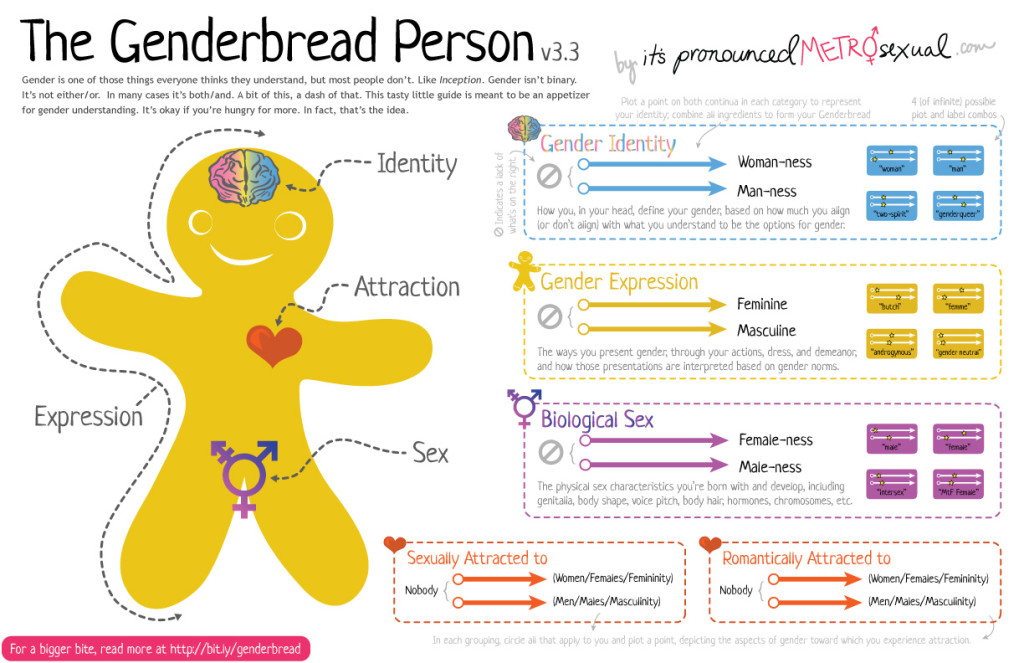Why is it harder for guys to act more feminine?
Featured image by: vcl xla
As my musical childhood idol Julia Roberts used to sing, “Boys in white dress with blue satin sashes.” Wait, that’s not right? Let my try again.
Now when I was younger my mother always told me, “Blue is for girls and pink is for boys.” Still seem wrong? Why? First, let’s set a foundation.
Genetics don’t mean Gender
In recent years people have delved deeper into the analysis of sex and gender, and have put forth some interesting results. They have found that sex and gender are two separate fluid things, that intersect in many different ways. Sam Killermann’s Genderbread person is a wonderful diagram that explains this perfectly.
 Image by Sam Killermann
Image by Sam Killermann
Social media and the internet have also been essential in providing a greater understanding of gender. For instance, Facebook has recently created over 50 options for gender when creating a profile. With the help of social media younger generations have become increasingly open minded in regards to gender. In fact, according to recent surveys half of millennials believe that gender exists on a spectrum. This change in perceptions of gender has resulted in a radical shift in what is considered “appropriate attire” for cis males and females.
What does clothing have to do with anything?
Clothing is a large part of gender expression. Before the mid-19th century children’s clothes were pretty gender neutral. The unisex style at the time actually tended to lean to today’s standards of femininity, as up to age six boys and girls both wore white dresses and kept their hair long. The stereotypical pink for girls and blue for boys did not develop until after World War I, and even then it was often reversed or muddled. Later, with the women’s liberation movement the unisex style became more masculine. Today people dress in a variety of ways in order to express themselves. As Mark Twain once said. “Clothes make the man. Naked people have little or no influence on society.”
What about gender and clothing today?
The fact is, it’s a lot easier to wear traditionally masculine clothing as woman than it is to present more effeminately as a man. Today, supposedly “androgynous” models are often flat chested short haired cis women dressed in loose fitting clothing. Scrolling through Pinterest you’ll see hundred of pictures of “hipster style girls” in large over sized flannel and sweatshirts. In shopping malls you can find twenty different types of “boyfriend” jeans, shirts, and cardigans all targeted towards a generally female audience. In the workplace, women are no longer restrained to wearing dresses and pencil skirts and can now comfortably roam the office in slacks.
But when was the last time you saw a cis guy wearing a dress with the ease some women wear necktie? Or wear heels to a job interview as comfortably as his female college dons her Oxfords? Where are all the girlfriend jeans?
Why is effeminate attire so strictly regulated to women while masculine style seems open to all?
Why can’t guys wear dresses?
Well physically, they can. The problem is: Will society let them? This is an issue that stems from the gender binary and the gender roles it creates. First, lets take a look at language. Most insults directed at men attack their masculinity (sissy, girl, crybaby) whereas insults towards women are dehumanizing (bitch, cow). The problem is these insults imply that femininity is derogatory. Likewise, young boys are often encouraged to suppress their emotions. As crying is seen and a “feminine” behavior. In fact, a 2001 study reported that 23% of of males reported crying when feeling helpless as opposed to 58% of females.
It’s easier for women to act more emasculate because society implies that feminine qualities are degrading. On the other hand, men are pressured to be as manly as possible as if being too girly would be lowering themselves. Masculinity is considered empowering and femininity is not.
Additionally, women’s clothing is downright more expensive. I can’t blame guys for avoiding pricey skirts and lacy tops in favor of cheaper more durable clothing with pockets. “Pink tax,” has been an accepted economic phenomenon since a 1995 California study that revealed women pay $1,351 a year more for the same products as men. This video shows a modern day replication of the experiment.
Finally, women’s clothing is often highly sexualized. One study showed that out of 15 major retailers about 30% of clothing marketed towards young girls had at least one sexualizing feature. Women’s clothing is also often used as a “justification” for sexual harassment and even rape. Anna Bikovitz puts this perfectly in her poem “Asking For It:” “Stop asking people’s clothing to have sex with you, and start asking people.”
Will this ever change?
Attitudes are beginning to change. With male celebrities like Jaden Smith, Kanye West, Vin Diesel and Marc Jacobs donning skirts and dresses the idea of a more womanly man is gaining acceptance. French artist Stromae has recently produced a song Tous Les Mêmes, that challenges binary gender stereotypes. Even if you cannot speak French, the green and pink lighting is pretty easy to understand.

I really like your blog. I haven’t looked at clothing in this way before.